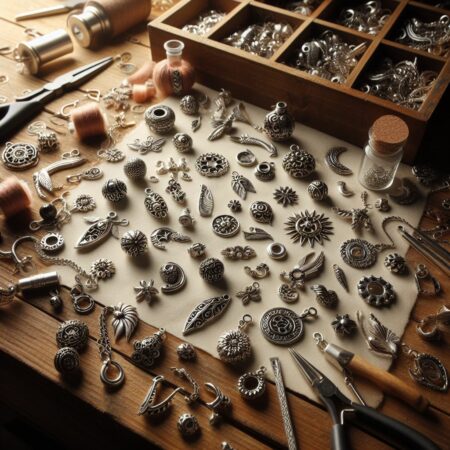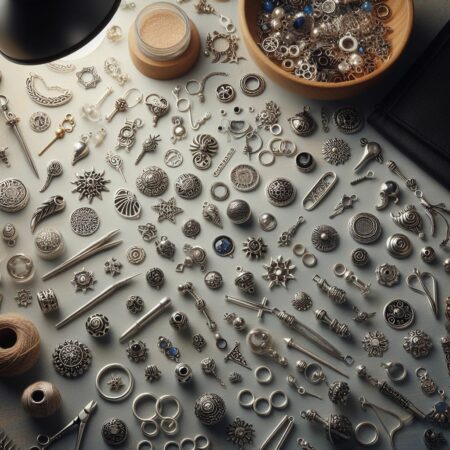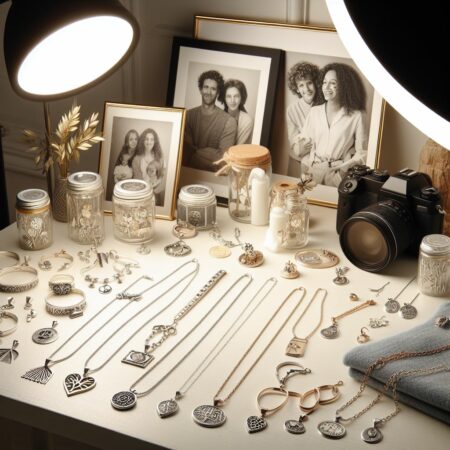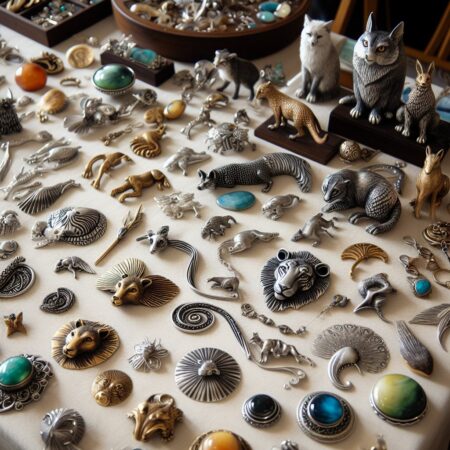Jewelry is likely the oldest artifact of human civilization. As part of the jewelry trends of every era, it bears not just the popular look of the day but also bits and pieces of history. Archeologists and anthropologists have learned a lot from the primitive jewelry pieces during the various ages of prehistory. The history of jewelry never stopped despite two World Wars, the Great Depression in the United States, and many other pivotal events that defined the economy and how people lived.
The 1940s Jewelry Trends

It all started with the now-iconic tagline “A Diamond is Forever,” which encapsulated the diamond’s eternal promise and convinced American ladies that they required a diamond engagement ring. This was one of the defining moments of the jewelry trends of this era.
Since that time, couples have made diamond engagement rings a tradition. The 1940s also saw an increase in yellow and white gold use because of the scarcity of platinum during WWII. Additionally, the war cast an emphasis on American designers and jewelry compared to international designs.
Due to the changing social dynamics of the 1940s, the 1940s were an exciting decade for fashion and jewelry. However, jewelry manufacturers faced numerous obstacles, including a wartime economy and a shortage of access to precious metals, which the US military was stockpiling for the war effort.
Nevertheless, when material constraints and a lack of access to precious gemstones limited manufacturers, they could create timeless pieces that remain famous well into the twenty-first century.
During the early 1940s, jewelry and jewelry trends were defined by sculpted, non-essential metals bearing curvy shapes and figural designs; due to a scarcity of metals, jewelry designers designed methods using alternate materials such as Bakelite, a lightweight plastic material. In the latter half of the 1940s, jewelry designs incorporated patriotic color schemes, deco-inspired metalwork, and vibrant gemstones.
As European jewelry designers gained traction in the American market, they could diversify the jewelry options offered to buyers. As a result, European designers had more accessible access to the costly gemstones that ultimately became synonymous with 1940s vintage jewelry.
Due to the increased demand for precious metals, numerous jewelry designers designed necklaces and bracelets using non-precious metals such as yellow, green and rose gold. Due to the scarcity of silver, designers frequently used sterling in its place. Toward the end of the decade, designers shifted away from marbled plastic necklaces and bracelets and more conversational designs embellished with rhinestones and brilliantly colored gems.
Topaz, citrine, amethyst, rubies, and sapphires were among the most popular stones in 1940s jewelry trends . Often, American designers were able to secure these precious stones with the assistance of European jewelers who possessed a more excellent supply of these materials. In addition, a red, white, and blue theme were one of the most popular color schemes for jewelry during this era, as it embodied the American spirit.
The cocktail party was a popular type of entertainment in the 1940s, and ladies frequently wore enormous, striking cocktail rings to these events. Cocktail rings were adorned with exaggeratedly large brightly colored stones cut in angular, rectangle, and square shapes. These sculptures were created to spark conversation and provided an excellent opportunity for women to experience Hollywood elegance. Numerous leading actresses of the decade, like Katherine Hepburn and Eva Gardner, wore oversized cocktail rings in their films.
Another popular 1940s jewelry fad was retro-style heart pins on hats, scarves, and collars. Made of sterling silver, colored gold, and occasionally valuable stones, these pins are excellent collector’s items that are now fashionable. Nails were typically shaped like animals, clowns, and ballerinas. Additionally, these pins were designed to resemble beautiful bows and knots.
The 1950s Jewelry Trends

Is anyone familiar with the television show Leave it to Beaver? June Cleaver was well-known for always wearing her string of pearls—even when doing housekeeping and gardening. The 1950s were known for their more sophisticated aesthetic, including pearls and matching jewelry sets for the ideal “put together” appearance.
Costume jewelry saw a global popularity spike in the 1950s. Jewelry designs were simple, bright, elaborate, and complemented flawlessly with an ensemble.
Costume jewelry grew as a result of the decade’s greater purchasing power. As a result, 1950s costume jewelry was ideal for facilitating the trend for women to appear well-groomed.
While the war years ushered in austerity, the next decade provided much-needed reform, the 1947 premiere of Dior’s Corolle collection was particularly significant. Dior’s idealized depiction of femininity was typified by a defined waistline and long flowing skirts. This shape would define the decade that followed, serving as the quintessential picture of the 1950s lady.
This romantic spirit pervaded all areas of women’s lives during this era, even their closets and jewelry boxes. While novelty patterns and patriotic hues remained popular, they were being phased out in classic vintage jewelry shapes and colors.
Ladies wore matching sets of jewelry to reinforce the desire for women to look considered and matched. A parure is a collection of jewelry pieces designed to be worn together.
Women typically wore coordinating earrings, brooches, rings, necklaces, and occasionally bracelets.
For several decades, pearls were a popular choice of jewelry. However, in the 1950s, pearls experienced a rapid surge in popularity. They were the ideal accompaniment to the little black dress. Black and white was an exquisite combination. Additionally, other pearl colors were available: champagne, coffee, lemon yellow, cream, and grey, all of which complemented a woman’s complexion and attire. Strand lengths were typically very short to allow for visibility above a modest neckline but could also be very long, as seen in the mid-1950s waist-length necklace trend. In addition, they sported tailored suits, afternoon gowns, twin sweater sets, and cigarette pants.
Single double-strand necklaces or a single pearl stud earring for most daywear outfits was needed. While women with pierced ears could wear drop pearl earrings, most women wore clip-on or screw-back earrings.
It was considered impolite to wear showy jewelry throughout the day for decades. However, wearing jewelry throughout the day was encouraged in advertisements, celebrity endorsements, and wardrobe design. For example, twinset sweaters and long sleeve shirts ended at “bracelet length,” allowing for the visibility of a chunky or glittering bracelet rather than being buried beneath bunched sleeves. Suits for women featured big chest pockets ideal for framing a cluster of brooches. Additionally, open necklines accentuated the brilliance of bib necklaces and layers of beads against the skin.
Numerous fashion designers did not wait for consumers to purchase jewelry separately; they incorporated it into their designs. Rhinestones were sewn onto gowns, belts, and collars. On hats, chignon hair wraps, and purses, pearls were beaded. Nothing was left undisturbed. Each ensemble cried out for some spectacular jewelry.
In the mid-1950s, women powdered their eyelids bright azure blue and painted their lips vivid coral. As a result, this trend permeated costume jewelry. In the 1950s, bolder colors gained appeal, moving away from primary hues and toward shiny metals, saturated tropical and soft pastels. However, red was the only primary hue that remained popular until the 1950s. Summer attire was decorated boldly with earrings, earring wires, belts, bangles, and red beads.
The 1960s Jewelry Trends

The 1960s saw a dramatic shift in fashion, with brighter colors, layered necklaces, stacked rings, and bracelets, as well as handmade plastic and wooden accessories. Women wearing these fashions felt a greater sense of liberation, and they embraced it in the same way that the flower power movement did.
Initially, 1960s costume jewelry resembled that of the previous decade. But a shift was afoot. Designs become more audacious and expressive. By the decade’s close, 1960s jewelry styles had evolved from conventional dazzling gold parures to stunning bold creations from inexpensive polymers. In addition, super classic femininity was being phased out in favor of the Space Age.
Suddenly, 1960s women’s fashion was available and affordable to all. The growth of ready-to-wear apparel, combined with the rise of clothing manufacturers, resulted in a mass manufacturing market. Natural materials were supplanted by synthetic fabrics and fibers that resembled plastic. The fashion industry was facing a revolution.
Designers of costume jewelry during the time also experimented with novel materials and techniques. Numerous designers rejected the notion of jewelry as a status symbol, opting instead for low-cost materials. The 1960s’ new low-cost, low-value designs prepared the way for a fundamentally different attitude to fashion and consumption.
At the start of the decade, 1960s jewelry styles (like fashion) were eerily similar to those of the preceding decade, the 1950s. The use of gold, colorful pearls, and dazzling paste remained popular. However, jewelry designers began experimenting with the idea of designing jewelry with a textured surface. In the late 1950s and into the 1960s, textured gold was fashionable. Additionally, additional textures emerged. By fusing gold onto gold, a gritty look was achieved that dulls the brightness of the gold.
Additionally, crumpled and hammered textures were fashionable. Other metals were also used during this decade in addition to gold. The gloss and shine of rhinestones had faded into obscurity by the decade’s close. On style were new sleek metal designs with minimal or no accompanying embellishment. The shapes used in jewelry creation were considerably bolder, almost sculptural. In the 1960s, fashion and art were inseparable. With its simple, understated cut, the mod shift dress provided the ideal backdrop for showcasing Pop and Op Art prints. Op Art utilized a monochromatic palette to create complex designs and patterns, which resulted in optical illusions. Jewelry designs complemented these trends. Black and white 1960s jewelry styles became affordable using low-cost plastics.
Early plastics like Catalin and Bakelite were developed at the turn of the century. By the 1960s, technological advancements had resulted in the development of new plastics. Designer Kenneth Jay Lane makes a statement with substantial rhinestone-encrusted plastic jewelry. Audrey Hepburn and Elizabeth Taylor used his jewels frequently.
Perspex, vinyl, and resin could be mass-produced at a minimal cost. Other inexpensive materials were paper, PVC, Lucite, and leather. They facilitated the emergence of new ‘pop’ colors: yellow, orange, turquoise, and vibrant pink. Jewelry designers jumped at the chance to create designs using these new affordable materials.
For generations, jewelry makers have drawn inspiration from floral motifs. In the 1960s, floral designs became more prominent as new plastics were developed. Flower Power was born out of the Hippie movement in the decade’s later years. This trend permeated fashion, with flowery designs becoming increasingly popular.
The 1970s

The ’70s in a nutshell! We’re talking bohemian fashions and ginormous golden disco earrings. The hoop earrings were so large that they nearly touched the shoulders. Beaded necklaces evolved into fashion statements in an array of hues. Brightly colored gemstones, such as turquoise, helped distinguish this era’s flowy outfits and loud prints.
In many ways, the decade of the 1970s was a continuation of the decade preceding it. This era saw enormous political and social transformations in the Western world. The hippie lifestyle, disco fashions, and the call for equality and freedom inspired style in the 1970s. It was all about uniqueness and self-expression, reflected in people’s fashion choices. Contrary to popular belief, the counterculture was not interested in purchasing high fashion; instead, high fashion was what they wore.
In the 1970s, many new jewelry styles were inspired by non-Western cultures and achieved enormous appeal. Jewelry designs needed to be bold enough to stand out against the era’s diverse styles: hippy, unisex, disco, punk, ethnic, gypsy, classical, indigenous, sports, and bohemian. Today’s jewelry incorporates some features from 1970s jewelry, such as natural materials, the layering of necklaces, and influence from different cultures.
In the 1970s, loud designs and flowy gowns were popular, and consumers desired large, bold gemstones to stand out against their clothing.
Turquoise was a prominent gemstone, as was malachite and lapis lazuli. Not only were these jewels bold and brilliant, but they were also less expensive, making them more attractive.
Gold maintained its appeal throughout the 1960s and 1970s. Gold’s warm tone complemented the autumnal hues of oranges and browns that dominated interior design during this era.
Along with gold, silver gained broad popularity during this decade.
In the 1970s, puka shells sparked a revolution, and their jewelry was greatly sought. Due to the inherent piercing of puka shells, they were strung into necklaces, bracelets, and anklets. In addition, their varying size and unusual appearance added an element of uniqueness to the jewelry. Later, when demand for ‘puka beads’ increased, shells was sourced as raw material and cut and drilled to create ‘puka beads.’ David Cassidy has been heavily responsible for spreading their popularity throughout the world. Men, too, donned puka shell jewelry with zeal.
The 1980s

From hairstyles to clothing, the ’80s were all about big. Punk rock became fashionable, and bold statement earrings were worn with leather jackets. Madonna was a prominent fashion symbol in the 1980s, and she was known for wearing large statement pieces of jewelry and a plethora of bracelets up each arm.
Everything was enormous and dramatic in the 1980s, from hairstyles to shoulder pads. Jewelry was likewise huge, vivid, and distinctive to complement these surprising fashion trends. Unlike earlier decades’ jewelry, which featured small and inconspicuous necklaces and pendants, the 1980s ushered in the era of mixed metal jewelry, giant beaded necklaces, massive earrings, jelly bracelets, and large brooches.
An emphasis on individualism defined the 1980s. As a result, jewelry evolved into something more than a fashion piece; it became a way to express oneself.
While the wealthy and famous could demonstrate their wealth by wearing large and stylish fine jewelry, most people opted for costume jewelry. This was mainly due to financial constraints. A vast, heavy gold necklace would have been prohibitively expensive for most people. However, it was also owing to jewelry designers seeking to push the frontiers of design and experiment with new and unusual materials.
From oversized hoop earrings to neon bracelets, the 1980s clothes were defined by various jewelry types and styles. Earrings in the 1980s were huge and extravagant. Large hoop earrings were a must-have accessory for any 1980s woman. Clip-on earrings were popular since pierced designs were frequently unwearable due to their weight. Gold disc earrings were exceptionally stylish, complementing the giant gold buttons adorned jackets and blazers. It was all about imitation pearls and false jewels.
Necklaces came in a multitude of styles, from beaded ones to massive pendants.
Again, gold was a prominent component of many 1980s necklaces, whether genuine gold or gold-plated pieces. Additionally, crystal and cut glass were popular, complementing other forms of jewelry that featured natural gemstones. Long ropes of fake pearls were worn plain, in bunches, or with the ends knotted.
Brooches saw a renaissance in popularity in the 1980s. Whereas brooches were previously considered to be a little out of date, 80s fashion jewelry styles demanded brooches that were as huge and dramatic as other pieces of jewelry.
Cocktail rings and other costume jewelry were a staple of 1980s fashion. These were worn during the day and night and contributed to the decade’s sense of luxury and confidence.
Like other 1980s jewelry trends, Bracelets make a comprehensive, strong statement. Then, it was fashionable to wear large bangle bracelets and a slew of thin bangles. Jelly bracelets in neon hues were a must-have for the younger demographic, who wore as many as their arms could comfortably accommodate. Also popular were woven friendship bracelets, charm bracelets, and cuffs.
Read the amazing story of Far Fetched Imports, an iconic and ethical jewelry line that began in the villages outside Taxco, Mexico.
The 1990s

Fashion and jewelry trends in the ’90s were out of control. The school was completely taken over by neon colors, mood rings, and chokers. The cheesier, the better the accessories, like Care Bear charm bracelets, dolphin necklaces, and yellow smiling face bubble rings. It was all bright, flashy, and enjoyable!
Jewelry of the 1990s was wildly varied, and its accessibility ensured that it spread like wildfire. Anyone can wear a plastic tattoo choker or create a shell necklace. Additionally, it shared several of the most significant elements of the decade’s major fashion trends.
Specifically, they were wild and intensely personal, with a costume quality that allowed anyone to experiment with various products. That celebrity style was everywhere for the public to take inspiration from (whether through films, television programs, or music)! This fashion flourished at the start of the decade and remained quite popular until 1995. Being grunge meant being a part of a movement with a particular view of the world, and wearing it meant sending an unmistakable message: that you were anti-system and focused on doing your wild, free-spirited thing!
The style expanded into New Age terrain as the decade progressed, incorporating energy-related features such as natural stones and power beaded necklaces. In addition, a more spiritual approach combined Indian knowledge, chakra study, Reiki, and Feng Shui, among other things.
Long skirts, knitted cardigans, and batik tees were the preferred looks, paired with layered necklaces, mood rings, and ear cuffs. Additionally, gemstones and semi-precious stones were highly valued!
Drew Barrymore opts for a tattered leather jacket with an ancient long bronzed Irish knot necklace over a purple blouse in her film Poison Ivy. Add a long pendant with amethyst and a nice pair of earring studs to a see-through tee and weathered jean shorts combo to achieve the look.
Around 1992, hip hop music’s influence spread to the mainstream, popularizing baggy jeans, tracksuits, and sportswear heavily associated with rappers.
Due to the ethnic diversity of the performers behind these genres of music, Latino jewelry pieces like extra-large hoop earrings were popular. They were worn by various artists, including Beyoncé from Destiny’s Child and Christina Aguilera.
The preppy style was defined by informal conservative attire with an unmistakable private-school atmosphere. Khaki slacks, canvas boat shoes, and monogrammed blazers were popular with the wealthy children who wore them.
Polished shirts in delicate materials such as tartan skirts, organza in pastel hues, and denim jackets were popular, particularly when matched with natural beaded necklaces and rubber jelly bracelets.
The 2000s
When you examine the jewelry styles of this generation, you will see a strong influence from the past. In the fashion industry, trends, styles, and colors are recycled. People currently wear both fresh and classic fashions. Today’s jewelry fashion honors the beauty of each decade and allows for greater expression than ever before.
Although dainty jewelry styles such as gold medallion necklaces and croissant rings have dominated recent seasons, the hottest jewelry trends right now are bold, colorful, and largely devoid of metal components in favor of fun, plastic, or blown glass designs. These It-accessories may feel all too familiar to ’90s babies—from beaded trinkets to stackable bracelets, the revival of 2000s jewelry trends sets the stage for a wave of creativity-fueled accessorizing with enough minimalism to please the most conservative folks.
One of the reasons [the 2000s] has regained popularity is that there is more creative freedom in repurposing and redefining the decade’s best aspects. Rejecting “today’s mainstream fashion senses” in favor of historical trends allows for sartorial escapism and encourages experimentation. The simplest way add pizzazz to your everyday look is to incorporate eccentric designs or splashes of color that you might not usually go toward, which is essentially what these fun-loving Y2K trends are all about.
Take a journey down memory lane by reintroducing beaded necklaces and bracelets. However, dreamy, mystical designs are taking center stage this time around. When it comes to Y2K style, more is more, which means layering. So there you have it: plastic bangle bracelets. So naturally, the resurgence of chunky rings created space for its sister accessory, and both share the concept of stacking and combining hues. While much of the Y2K jewelry trend resurrection is reminiscent of designs worn by individuals growing up in the 2000s as tweens and adolescents, the waist chain (or belly chain) is the daring trend you may recall appreciating on the red carpet, championed by celebrities such as Aaliyah, Rihanna, and Christina Aguilera.
It was abundantly clear in the realm of earrings, necklaces, rings, and bracelets this season that there is a strong current of Y2K jewelry and ideals—and let’s not forget the regencycore style. Consider layered pearls, bright chunky rings, layers of handmade beads, resin bangles, and, yes, even body jewelry—hello, belly chains, and anklets. The same is true of bulky gold jewelry from the 1980s and early 1990s, ranging from thick collar necklaces to heavyweight chains to oversized and super chunky rings and earrings.






